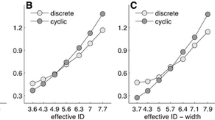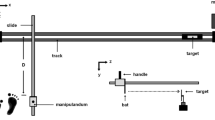Abstract
In this study we asked whether Fitts’ Law, a well-established relationship that predicts movement times (MTs) for direct movements between two positions, could be extended to predict MTs for curved, obstacle avoiding, movements. We had participants make movements in the presence of an obstacle. Using these data, we tested an extensions of Fitts’ Law that predicted MTs based on the movement’s index of difficulty and the distance that the obstacle intruded into the direct movement path. Including both factors led to more accurate predictions of MTs for obstacle-avoiding movements than was possible with the index of difficulty alone. In addition, the simple extension of Fitts’ Law did as well as a model which relied on the obtained movement paths between targets. This is an encouraging outcome because it suggests that the physical layout of the workspace can be used to predict MTs for obstacle avoiding movements, an accomplishment that fits with the spirit of Fitts’ Law.


Similar content being viewed by others
Notes
The end-of-block score also encouraged participants to initiate their movements as quickly as possible. These initiation times did not differ between obstacle present and obstacle absent blocks (means of 461 and 449 ms, respectively; P = 0.62 for a t test of the difference). We have observed such equivalence in another recent study of obstacle avoidance (Jax and Rosenbaum 2007).
In addition to the formulation of Fitts’ Law presented in Eq. 1, we also tried to predict MTs using the Shannon formulation of index of difficulty (see MacKenzie 1992), but found that the original formulation was able to account for a slightly higher proportion of variance in our data set (R 2 of 0.847 vs. 0.832 in the obstacle-absent condition, and 0.225 vs. 0.209 in the obstacle-present condition).
OI, and not log2(OI), was used in both regressions because in both cases OI was able to account for a slightly higher proportion of variance in our data set. For the OI alone model, R 2 values were 0.420 and 0.381 using OI and log2(OI), respectively. For the ID and OI model, the adjusted R 2 values were 0.886 and 0.856 using OI and log2(OI), respectively.
References
Accot J, Zhai S (1997) Beyond Fitts’ law: models for trajectory-based HCI tasks. In: Proceedings of ACM CHI 1997 conference on human factors in computing systems, pp 295–302
Accot J, Zhai S (1999) Performance evaluation of input devices in trajectory-based tasks: an application of the steering law. In: Proceedings of ACM CHI 1999 conference on human factors in computing systems, pp 466–472
Accot J, Zhai S (2001) Scale effects in steering law tasks. In: Proceedings of ACM CHI 2001 conference on human factors in computing systems, pp 1–8
Adam JJ, Mol R, Pratt J, Fischer MH (2006) Moving farther but faster: an exception to Fitts’s Law. Psychol Sci 17:794–798
Beamish D, Bhatti SA, Mackenzie IS, Wu J (2006) Fifty years later: a neurodynamic explanation of Fitts’ law. J R Soc Interface 22:649–654
Bullock D, Bongers RM, Lankhorst M, Beek PJ (1999) A vector-integration-to-endpoint model for performance of viapoint movements. Neural Netw 12:1–29
Dean J, Brüwer M (1994) Control of human arm movements in two dimensions: paths and joint control in avoiding simple linear obstacles. Exp Brain Res 97:497–514
Dean J, Brüwer M (1997) Control of human arm movements in two dimensions: influence of pointer length on obstacle avoidance. J Motor Behav 29:47–63
Fitts PM (1954) The information capacity of the human motor system in controlling the amplitude of movement. J Exp Psychol 47:381–391
Jax SA, Rosenbaum DA (2007) Hand path priming in manual obstacle avoidance: evidence that the dorsal stream does not only control visually guided actions in real time. J Exp Psychol Hum Percept Perform 33:425–441
Lacquaniti F, Terzuolo C, Viviani P (1983) The law relating the kinematic and figural aspects of drawing movements. Acta Psychol 54:115–130
MacKenzie IS (1992) Fitts’ Law as a research and design tool in human–computer interaction. Hum Comp Interact 7:91–139
Mohagheghi AA, Anson JG (2002) Amplitude and target diameter in motor programming of discrete, rapid aimed movements: Fitts and Peterson (1964) and Klapp (1975) revisited. Acta Psychol 109:113–136
Pew RW, Mavor AS (eds) (1998) Modeling human and organizational behavior: applications to military simulations. National Academy Press, Washington, DC
Plamondon R, Alimi AM (1997) Speed/accuracy trade-offs in target-directed movements. Behav Brain Sci 20:279–303
Ritter FE, Shadbolt NR, Elliman D, Young R, Gobet F, Baxter GD (2003) Techniques for modeling human and organizational behaviour in synthetic environments: a supplementary review. Human Systems Information Analysis Center, Wright-Patterson Air Force Base, OH
Todorov E, Jordan MI (1998) Smoothness maximization along a predefined path accurately predicts the speed profiles of complex arm movements. J Neurophysiol 80:694–714
Viviani P, Flash T (1995) Minimum-jerk, two-thirds power law, and isochrony: converging approaches to movement planning. J Exp Psychol Hum Percept Perform 21:2–53
Wada Y, Kawato M (2004) A via-point time optimization algorithm for complex sequential trajectory formation. Neural Netw 17:353–364
van der Wel PRD, Fleckenstein R, Jax SA, Rosenbaum DA (2007) Hand path priming in manual obstacle avoidance: evidence for abstract spatio-temporal forms in human motor control. J Exp Psychol Hum Percept Perform (In press)
Acknowledgments
This work was supported by grant F31 NS 047784-01 from the National Institutes of Health to SAJ, and by grant SBR-94-96290 from the National Science Foundation, grants KO2-MH0097701A1 and R15 NS41887-01 from the National Institute of Mental Health, and grants from the Research and Graduate Studies Office of The College of Liberal Arts, Pennsylvania State University, to DAR. We thank Jeremy Graham for help with programming and data collection and to an anonymous reviewer for his or her helpful suggestions.
Author information
Authors and Affiliations
Corresponding author
Rights and permissions
About this article
Cite this article
Jax, S.A., Rosenbaum, D.A. & Vaughan, J. Extending Fitts’ Law to manual obstacle avoidance. Exp Brain Res 180, 775–779 (2007). https://doi.org/10.1007/s00221-007-0996-y
Received:
Accepted:
Published:
Issue Date:
DOI: https://doi.org/10.1007/s00221-007-0996-y




